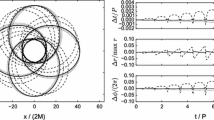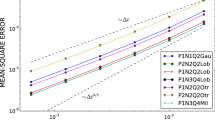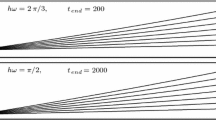Abstract
Explicit and semi-explicit geometric integration schemes for dissipative perturbations of Hamiltonian systems are analyzed. The dissipation is characterized by a small parameter ε, and the schemes under study preserve the symplectic structure in the case ε=0. In the case 0<ε≪1 the energy dissipation rate is shown to be asymptotically correct by backward error analysis. Theoretical results on monotone decrease of the modified Hamiltonian function for small enough step sizes are given. Further, an analysis proving near conservation of relative equilibria for small enough step sizes is conducted.
Numerical examples, verifying the analyses, are given for a planar pendulum and an elastic 3D pendulum. The results are superior in comparison with a conventional explicit Runge-Kutta method of the same order.
Similar content being viewed by others
References
Abraham, R., Marsden, J.E.: Foundations of Mechanics, 2nd edn. Benjamin/Cummings, Reading (1978)
Armero, F., Romero, I.: On the formulation of high-frequency dissipative time-stepping algorithms for nonlinear dynamics. I. Low-order methods for two model problems and nonlinear elastodynamics. Comput. Methods Appl. Mech. Eng. 190(20–21), 2603–2649 (2001)
Armero, F., Romero, I.: On the formulation of high-frequency dissipative time-stepping algorithms for nonlinear dynamics. II. Second-order methods. Comput. Methods Appl. Mech. Eng. 190(51–52), 6783–6824 (2001)
Gonzalez, O.: Time integration and discrete Hamiltonian systems. J. Nonlinear Sci. 6(5), 449–467 (1996)
Gonzalez, O., Simo, J.C.: On the stability of symplectic and energy-momentum algorithms for non-linear Hamiltonian systems with symmetry. Comput. Methods Appl. Mech. Eng. 134(3–4), 197–222 (1996)
Grabowski, J.: Free subgroups of diffeomorphism groups. Fundam. Math. 131(2), 103–121 (1988)
Hairer, E., Lubich, C., Wanner, G.: Geometric numerical integration illustrated by the Störmer-Verlet method. Acta Numer. 12, 399–450 (2003)
Hairer, E., Lubich, C., Wanner, G.: Geometric Numerical Integration, 2nd edn. Springer Series in Computational Mathematics, vol. 31. Springer, Berlin (2006)
Hansen, A.C.: A theoretical framework for backward error analysis on manifolds. J. Geom. Mech. 3(1), 81–111 (2011)
Hochbruck, M., Ostermann, A.: Exponential integrators. Acta Numer. 19, 209–286 (2010)
Holm, D.D.: Geometric Mechanics. Part I. Imperial College Press, London (2008)
Kane, C., Marsden, J.E., Ortiz, M., West, M.: Variational integrators and the Newmark algorithm for conservative and dissipative mechanical systems. Int. J. Numer. Methods Eng. 49(10), 1295–1325 (2000)
Kriegl, A., Michor, P.W.: The Convenient Setting of Global Analysis. Mathematical Surveys and Monographs, vol. 53. Am. Math. Soc., Providence (1997)
Lubich, C., Walther, B., Brügmann, B.: Symplectic integration of post-Newtonian equations of motion with spin. Phys. Rev. D 81(10), 104025 (2010)
Marsden, J.E.: Lectures on Mechanics. London Mathematical Society Lecture Note Series, vol. 174. Cambridge University Press, Cambridge (1992)
Marsden, J.E., Misiołek, G., Ortega, J.P., Perlmutter, M., Ratiu, T.S.: Hamiltonian Reduction by Stages. Lecture Notes in Mathematics, vol. 1913. Springer, Berlin (2007)
Marsden, J.E., Ratiu, T.S.: Introduction to Mechanics and Symmetry, 2nd edn. Texts in Applied Mathematics, vol. 17. Springer, New York (1999)
McLachlan, R., Perlmutter, M.: Conformal Hamiltonian systems. J. Geom. Phys. 39(4), 276–300 (2001)
McLachlan, R.I., Quispel, G.R.W.: Splitting methods. Acta Numer. 11, 341–434 (2002)
McLachlan, R.I., Quispel, G.R.W.: Geometric integrators for ODEs. J. Phys. A 39(19), 5251–5285 (2006)
Modin, K.: Adaptive geometric numerical integration of mechanical systems. Ph.D. thesis, Lund University (2009)
Modin, K., Perlmutter, M., Marsland, S., McLachlan, R.I.: On Euler-Arnold equations and totally geodesic subgroups. J. Geom. Phys. 61(8), 1446–1461 (2011)
Reich, S.: Backward error analysis for numerical integrators. SIAM J. Numer. Anal. 36(5), 1549–1570 (1999)
Smale, S.: Topology and mechanics. I. Invent. Math. 10, 305–331 (1970)
Author information
Authors and Affiliations
Corresponding author
Additional information
Communicated by Christian Lubich.
Presented at the BIT50 conference in Lund, Sweden, 17–20 June 2010.
Rights and permissions
About this article
Cite this article
Modin, K., Söderlind, G. Geometric integration of Hamiltonian systems perturbed by Rayleigh damping. Bit Numer Math 51, 977–1007 (2011). https://doi.org/10.1007/s10543-011-0345-1
Received:
Accepted:
Published:
Issue Date:
DOI: https://doi.org/10.1007/s10543-011-0345-1




